1. Hoi An Central Market
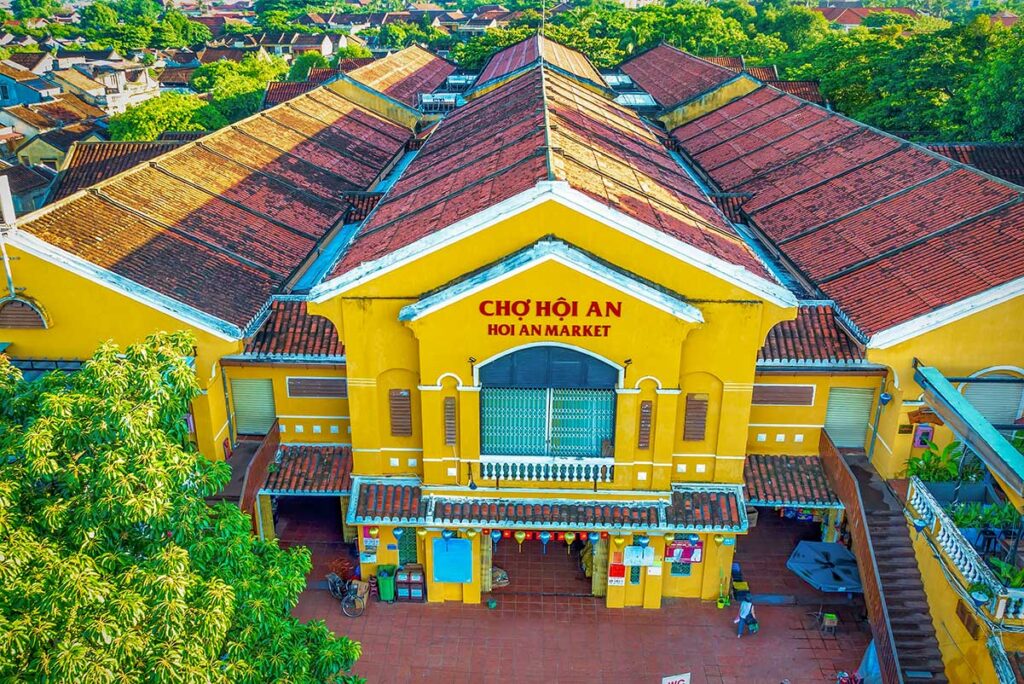
Hoi An Central Market is the busiest and most varied market in town. Inside, you’ll find a lively food court serving local breakfasts, rows of spice and tea stalls, and sections for meat and dried goods. Outside, fresh seafood and vegetables are stacked high, and souvenir vendors sell everything from hand-embroidered goods to lacquerware and chopsticks. It’s a sensory overload — noisy, colorful, and full of life.
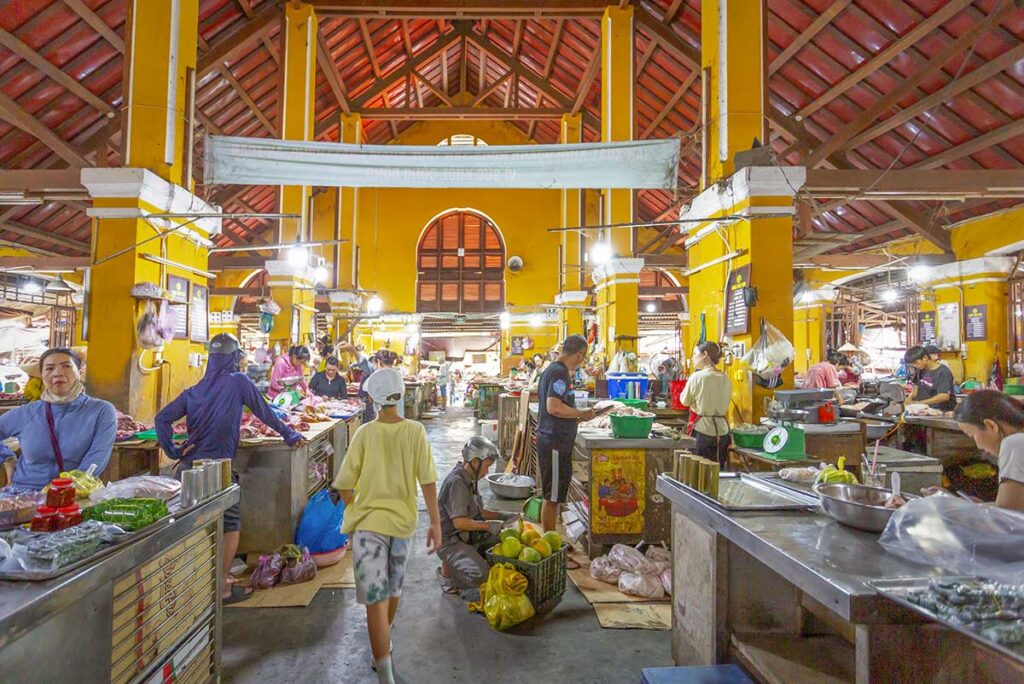
How to visit
The market sits right along the Thu Bon River, at the eastern edge of the Ancient Town, and is easy to walk to from most central hotels. It’s open daily, with peak activity from sunrise until around noon. Visit before 9:00 AM if you want to see the local side of the market — that’s when residents shop and fishermen deliver their catch. Later in the day, it’s busier with tourists. Combine it with a stroll through the Old Town or a visit to a riverside café. Bargaining is expected at souvenir stalls; cash only.
Hoi An Cooking Class – Learn Cooking from a Local Chef
- Experience: Cook authentic Vietnamese dishes with a local chef in a peaceful riverside kitchen.
- Includes: Market visit, vegetable garden stop, and hands-on cooking session with fresh local ingredients.
2. Hoi An Night Market
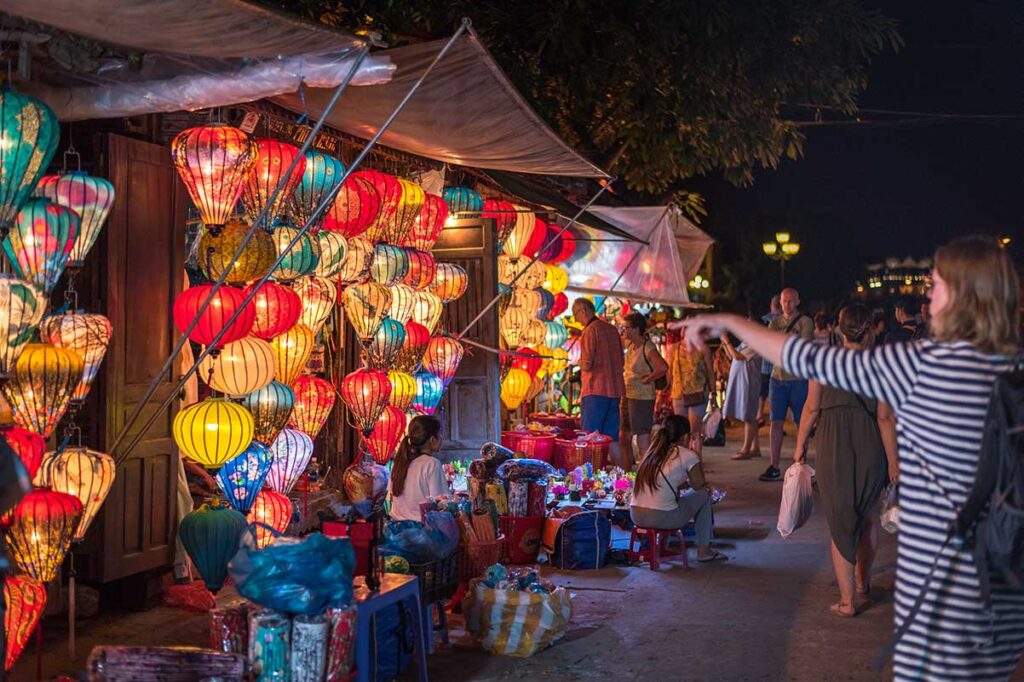
The Hoi An Night Market stretches along lantern-lined Nguyen Hoang Street on An Hoi Island, directly across from the Japanese Bridge. With around 50 stalls, it’s packed with souvenirs, jewelry, T-shirts, paper lanterns, and Vietnamese street snacks.
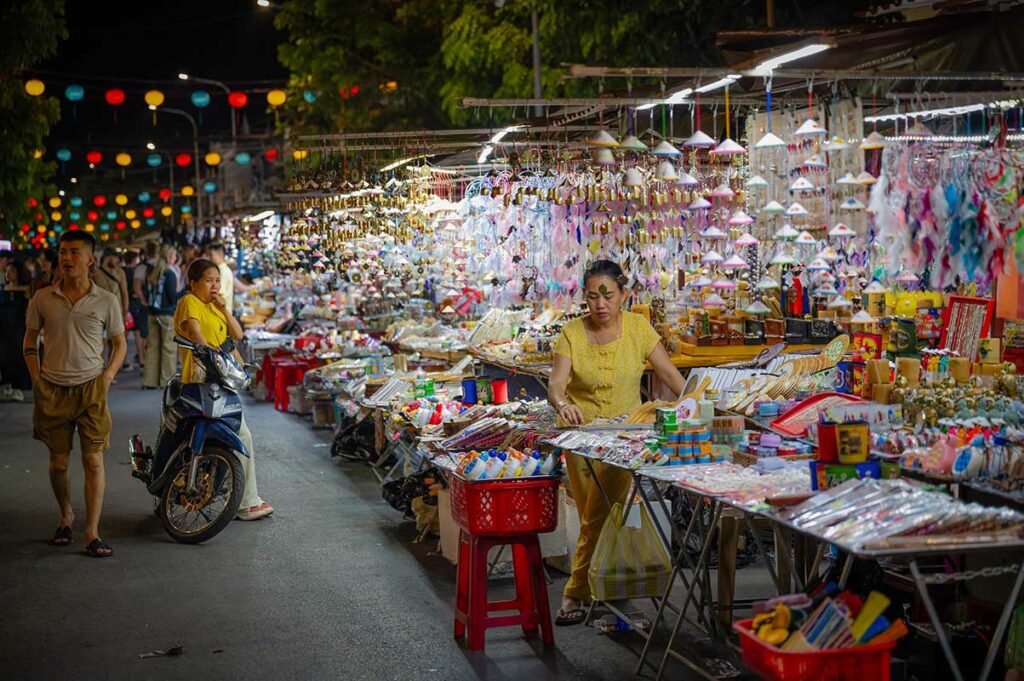
The setting is especially photogenic — colorful lanterns overhead, river views nearby, and a lively buzz that makes it ideal for an evening walk. It’s less about local shopping, more about the vibe.
How to visit
Open nightly from around 5:00 PM until 10:00 or 11:00 PM, this market is one of the most visited evening spots in Hoi An. It’s very tourist-focused, so prices can be inflated — bargaining is expected. Best to bring small cash (VND only), as few vendors accept cards. Combine your visit with dinner at a nearby riverside restaurant, or pair it with a lantern boat ride for the full Hoi An night experience. It gets busy after 7:00 PM, especially in high season.
3. Thanh Ha Fish Market
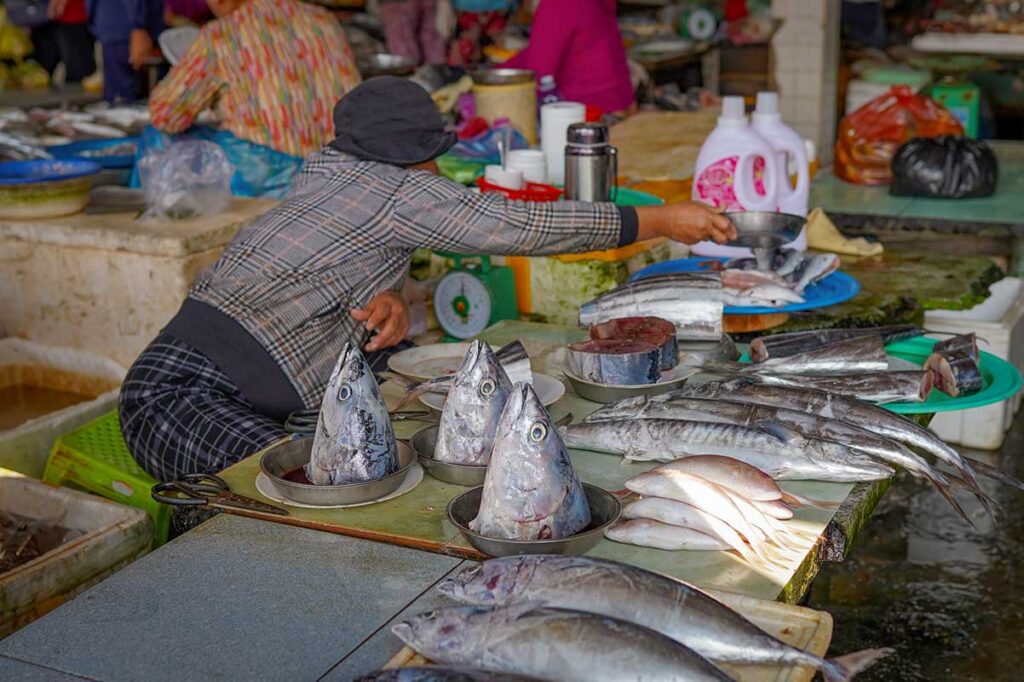
This early morning wholesale fish market is one of the most authentic and energetic scenes in Hoi An. Local fishermen haul in their overnight catch and sell it directly on the ground — often still alive or freshly gutted. Expect to see all kinds of seafood: from squid and shrimp to mackerel, clams, and crabs. The atmosphere is chaotic but fascinating, with shouting vendors, slippery floors, and baskets of seafood changing hands in minutes. It’s a raw glimpse into the fishing economy of the region.
How to visit
Thanh Ha Fish Market is located along the Thu Bon River in Thanh Ha village, about 3 km west of Hoi An Ancient Town. The best time to visit is between 5:00 and 7:00 AM when the market is most active. It’s best reached by bicycle, scooter, or short taxi ride — just don’t wear open-toed shoes, as the ground can be wet and fishy. Not touristy at all, so expect a few curious looks but also friendly locals. Combine with a visit to Thanh Ha Pottery Village nearby to turn it into a morning outing.
4. An Bang Market

An Bang Market is a small, no-frills local market tucked into the beachside village of An Bang. It’s where locals shop for their daily vegetables, herbs, fresh noodles, and seafood. You’ll also find simple breakfast foods, like sticky rice, bánh mì, or rice porridge. It’s calm compared to central markets and offers a genuine slice of morning life in a coastal neighborhood — no souvenir stalls, just a friendly, authentic vibe.
How to visit
he market is located along the main village road in An Bang, just a short walk or bike ride from most beach accommodations. It’s only open in the early morning, roughly from 5:00 to 9:00 AM. Best visited if you’re staying in the area or heading to the beach early. Pair it with a coffee at one of An Bang’s nearby cafés or a relaxed stroll before the sun gets too strong. A great stop if you’re into everyday culture, but skip it if you’re only interested in shopping.
5. Ba Le Market
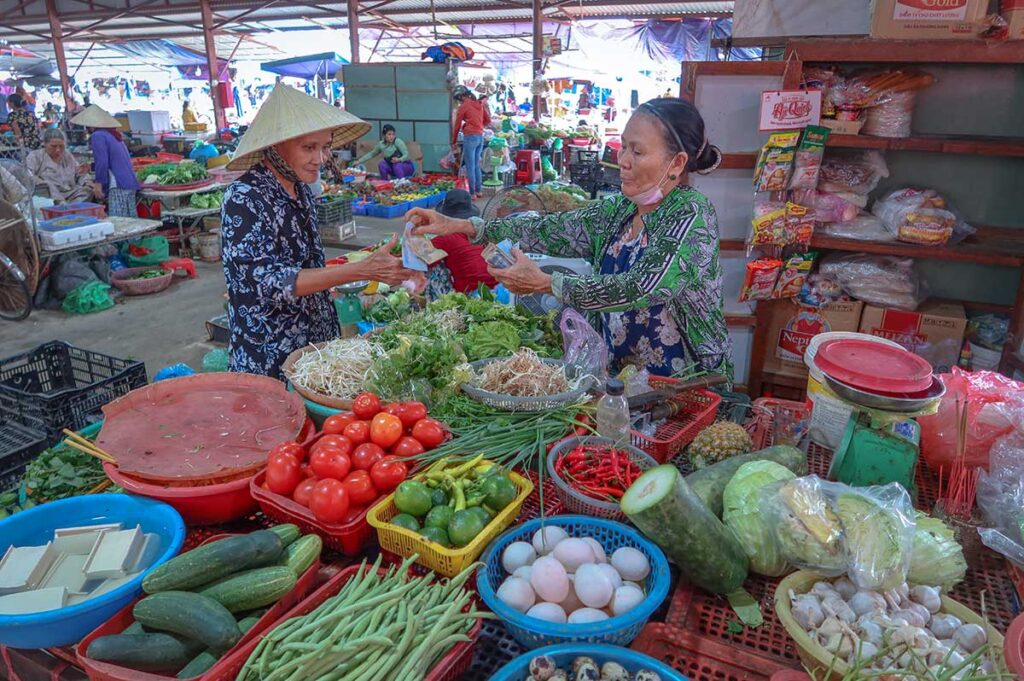
Ba Le Market is one of the most authentic markets in Hoi An, about 2 kilometers from the Ancient Town. It serves mainly local residents and nearby expats, offering a glimpse into real neighborhood life away from the tourist crowds. Inside, you’ll find everything from fresh vegetables, herbs, seafood, and meats to flowers, clothing, and household goods.

There’s also a wet market section with butchers, fishmongers, and fruit stalls, plus tailoring services and simple food vendors serving bánh mì, cao lầu, and chè desserts. The atmosphere is lively and community-focused — a place where neighbors chat, vendors call out prices, and the rhythm of everyday life unfolds naturally.
How to visit
Ba Le Market opens early, around 5:00–6:00 AM, and is busiest in the morning when produce and seafood are at their freshest. By midday, some stalls close, though fruit and dry goods sellers often stay open into the evening. It’s easy to reach by bicycle, motorbike, or taxi — about a 10-minute ride from central Hoi An.
Wear shoes with good grip, as the floors can be wet, and bring small cash (VND only) for purchases. While bargaining is possible, prices are generally fair. For travelers who enjoy seeing daily routines and authentic markets in Hoi An, Ba Le Market offers a great window into local life. Combine your visit with a nearby café stop or a morning cycling trip through the surrounding Cam Châu countryside.
6. Tan Thanh Flea Market

Tan Thanh Flea Market stands out from Hoi An’s other markets thanks to its eco-conscious and creative vibe. You’ll find second-hand clothes, upcycled goods, handmade crafts, jewelry, ceramics, and local art. Many vendors focus on sustainability — using banana leaves instead of plastic and offering thoughtfully made items. It’s not a place for bargaining or mass-produced souvenirs, but for discovering one-of-a-kind gifts or chatting with local creatives in a laid-back beachfront setting.

How to visit
The market takes place on weekends in the Tan Thanh beach area, located between An Bang and Hidden Beach. It usually runs from around 9:00 AM to 2:00 PM, though it’s best to confirm on social media or with nearby cafés. The vibe is casual and welcoming, often with music, food stalls, and even workshops or pop-ups. Combine your visit with brunch or coffee at a beachfront spot nearby. Bring cash and don’t rush — it’s the kind of place where browsing is part of the fun.
7. Tam Tien Fish Market
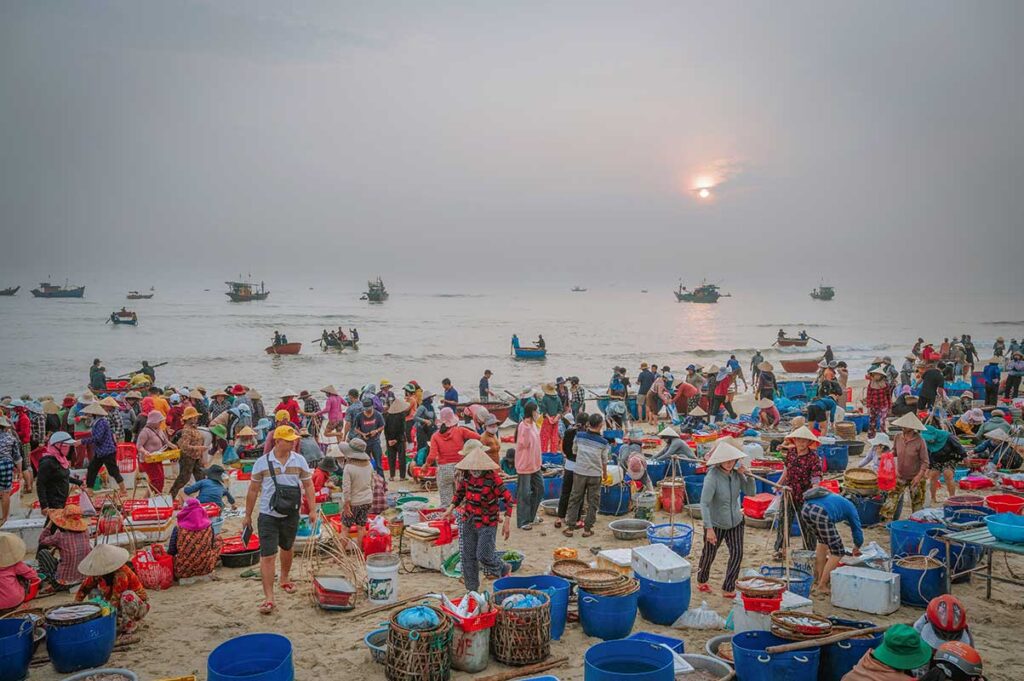
Tam Tien is the largest seafood market in Quang Nam — and unlike anything else near Hoi An. Set right on the beach, the action starts before dawn as basket boats shuttle the night’s catch from anchored fishing vessels to shore. The scene is fast-paced, raw, and full of color: piles of fish, prawns, squid, and crabs change hands within minutes. Women sort the seafood by type and quality, ice it down, and haul it off for delivery across the province. It’s a vivid snapshot of local coastal life.
How to visit
Tam Tiến is located about 48 km south of Hoi An (around 1 hour by car or motorbike) in Nui Thanh District. The market only runs during the dry season (April to September) and peaks from 3:30 AM to around 6:30 AM. You’ll need an early start — and a sense of adventure. It’s best visited with a private driver or as part of a photo or cultural tour. Don’t expect a polished tourist experience — this is real, gritty, and intense. Combine it with a sunrise beach walk and breakfast at one of the small local food stalls nearby.
Tips for visiting markets in Hoi An
If you want to explore the most authentic side of Hoi An, visiting its markets is a must — but it’s best to come prepared. Local markets can be crowded, chaotic, and unfamiliar if you’re not used to Vietnam’s vibrant street culture. Whether you’re shopping for fresh fruit, souvenirs, or snapping photos of the early morning fish trade, these tips will help you make the most of your market visits.
Local markets
These are traditional daily markets used mainly by local residents — like Hoi An Central Market, An Bang Market, and Thanh Ha Fish Market. Expect early starts, fast-paced trading, and a very local atmosphere.
Go early (Before 8:00 AM)
Most local markets open around 5:00 AM and are busiest before 8:00 AM. This is when you’ll see the real action — fishermen delivering seafood, locals buying breakfast ingredients, and stall owners preparing fresh produce. After 9:00 AM, the market quiets down, and the heat picks up. Early mornings also mean fewer tourists and better photos.
Prepare for strong smells and sights
If you’re visiting the meat or seafood sections, be ready for strong odors and the sight of raw meat, live fish, or even frogs. This is normal in Vietnam’s wet markets. If that’s not for you, stick to the dry goods or produce sections.
Wear closed shoes
Some parts of local markets — especially seafood areas — can be slippery or wet. Wear shoes with good grip and avoid sandals or flip-flops. It’s more comfortable and helps you walk around without worry.
Join a cooking class with market visit
One of the best ways to explore a market is as part of a local cooking class in Hoi An. Many classes include a guided visit to the Central Market, where you’ll learn to identify Vietnamese herbs, fruits, and typical ingredients — many of which you may have never seen before. Your guide will explain how locals shop, demonstrate how to bargain, and give insight into traditional Vietnamese cooking. It’s a great mix of culture, food, and fun — especially if you’re new to Southeast Asian markets.
Ask before taking photos
While many vendors don’t mind being photographed, it’s polite to ask first — especially at local-only markets or when photographing people directly. A smile and gesture often go a long way.
Souvenir & Night Markets
Markets like the Hoi An Night Market or Tan Thanh Flea Market cater more to tourists, with colorful lanterns, local snacks, and handmade or vintage products. These are best visited in the evening, when the atmosphere comes alive.
Bargain politely
Bargaining is part of the culture, especially at souvenir stalls. Start by offering around 50–70% of the asking price and work up from there. Be respectful, smile, and don’t haggle over small amounts — it’s meant to be fun.
Bring cash, especially small bills
Very few market stalls accept credit cards, and ATMs may not be nearby. Bring Vietnamese Dong in smaller denominations (10,000–100,000 VND notes) to make transactions smooth — especially for small purchases like snacks or street food.
Check for mass-produced items
Not all items labeled “handmade” are actually local. Look closely at lanterns, silk, and woodwork — if it looks too uniform, it may be factory-made. For more authentic souvenirs, visit smaller, artisan-run stalls or flea markets.




